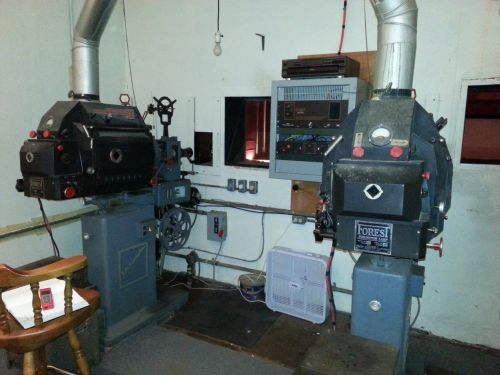|
|
 
|
|
Author
|
Topic: Article about a company that restores old film
|
Frank Cox
Film God

Posts: 2234
From: Melville Saskatchewan Canada
Registered: Apr 2011
|
 posted 08-31-2013 03:14 PM
posted 08-31-2013 03:14 PM





Indian Head isn't that far away from me, but I never knew that this outfit existed. If you go to their website (listed at the end of the article) they have lots of interesting facts about what they do and how they do it, with examples.
Exposing the past
quote:
INDIAN HEAD — The open vault in the centre of a 115-year-old re-purposed bank building is a fitting symbol of the work that attracts clients from around the world to this small-town Saskatchewan business.
“We essentially open time capsules for a living,” its website proclaims. “We get to open the doors to the past and be the first to look in.”
That we, is the staff of Film Rescue International (FRI), dubbed “revealers of lost and found treasures.”
Those treasures range from a long lost undeveloped film found in great-grandma’s attic to long forgotten film footage shot by a Hollywood legend. It all finds its way — by mail, courier or the rare walk-in — to this brick and Tyndall stone building on Indian Head’s main street, the unlikely base for an international business that has branches in Europe (Netherlands) and the United States (North Dakota). But the Indian Head office is where the real work begins — processing the vintage rolls of still and movie film, some as much as eight decades past their best before dates — and teasing images from them.
Cory Rennebohm, part of FRI’s staff who gets to peer into some of those windows on the past, has had a unique glimpse of what he describes as “history through other people’s eyes” — the Apollo 11 launch, Russian leader Leonid Brezhnev in Red Square for a military parade, the Vietnam and Korean wars, the liberation of Belgium in the Second World War, and countless vacation spots as they once were decades ago.
“We’ve got to see it from their point of view,” Rennebohm adds.
Owner Greg Miller admits he still gets a thrill out of revealing what’s been hidden for decades. Some of FRI’s more interesting work has included developing old film for the prestigious Smithsonian Institution; processing a roll of film, shot by Ladybird Johnson on the campaign trail of her husband, for the Lyndon B. Johnson Presidential Library in Texas; uncovering pictures of Peoples Temple cult founder Jim Jones (known for the 1978 murder/suicide of its members in Guyana by downing poison-laced grape drink) for the California Historical Society; handling some of the last family photos of actress Sharon Tate before she was murdered by Charles Manson’s followers; dealing with vintage film from Beatle George Harrison’s estate; and handling what may prove to be behind the scenes footage shot by movie director Francis Ford Coppola on the set of the Godfather.
One of the more bizarre requests Miller fielded was from someone who thought he had scenes from a real murder on a film shot in the 1950s.
“He asked if I would process it. I said, ‘I’ll process it, but if there’s a murder on there, I’m going to contact somebody about it.’ ... I never heard back from that guy.
“I’m very conscientious of when I would go to that point,” he adds.
Other compelling projects are hinted at, but not revealed due to confidentiality agreements. “We have a really interesting story, but can’t talk about it,” says Miller. “Eventually, it might be in a book,” adds Rennebohm, fuelling the mystery.
But it’s also some of the work for lesser-known people that is just as rewarding.
Rennebohm recalls one customer who was ecstatic to pull together photos of five generations of her family.
“Especially when you get the tears on the phone, you feel like you’ve really given someone part of their family tree back — a treasure that would have otherwise gone missing.”
FRI recently expanded its services to help preserve those family images from the past for future generations. It offers a scanning service for those who want to transfer all of those snapshots, slides, photo albums or home movies to digitized computer files that can be easily edited and shared.
“We can scan virtually anything,” says Miller. “I think it’s important for people to realize if they want to preserve their own families’ history that they need to start thinking about dealing with their family archives.”
Miller, a shutterbug from an early age, was working in the darkroom by the time he was 10. In his adult years, he moved on to motion picture film, opening his own processing company in Toronto in 1983 to cater to the movie business. But he increasingly had people turning to him to develop old still film rolls. In 1999, he and his wife/partner Tracy Gostick decided to move the business, swapping the hustle of a city of well over two million people for a kinder, gentler life in a town of less than 2,000.
“Saskatchewan has always felt like home,” says Miller, who has family in nearby Wolseley.
“People were like, what the hell are you moving there for,” Miller recalls. “I imagine most people thought we’d be here a few months.”
Fourteen years later, the business has 10 employees — although Miller, who lets them set their own hours, prefers that they be described as people who work “with” not “for” FRI. “He doesn’t like it when we call him the boss,” adds Rennebohm. He studied film in university but ended up working in an unrelated field. Five years ago, he joined the staff at FRI, where he heads the transfer department.
“His (Miller’s) best film rescue was me,” Rennebohm quips.
Miller and his partner were ecstatic to settle into the historic Union Bank of Canada building-turned-office space and were quick to renovate to reveal the old 14-foot high ceilings.
The two vaults, now used for storage are permanently blocked open — the combinations for the locks lost in time, unlike the film canisters that make their way there.
It’s not uncommon to encounter customers crying at the end of a phone line. FRI is often their last hope at getting an image off a long discontinued film format. “It’s the last glimpse you’ll have of the person,” notes Miller.
In some cases, they truly are the last photos as with people who died tragically while vacationing, their cameras surfacing sometime later.
Not every negative will result in a positive outcome, which is why FRI has a no-image-no-charge policy for still film. “We have a real motivation to get something off of each film,” he adds.
At FRI, it’s as much about chemistry as photography. Having worked with countless films of every variety, staff have learned what works best and doesn’t. They keep a database that’s akin to Colonel Saunders’ secret recipe, an archive of about 500 unique film types and the chemicals and developing processes that work best with each.
“Most people think Kodachrome is totally dead,” says Rennebohm. But not at FRI, where it can still be processed into black and white. Colour is impossible because the dyes that were added in processing don’t exist anymore. The company stopped making the film in 2008 and by 2010 all the chemistry for processing it was gone.
That isn’t all that’s gone.
“Most people don’t have the projection systems anymore,” says Rennebohm as he brings to life an old projector to play 9.5 mm film — a format that was more popular in Europe for nickelodeon-type movies from the 1920s. In his work transferring old movie film into digital files, Rennebohm often draws on equipment from a bygone era.
Some of the oldest still films FRI has processed are from the 1920s. (They’ve handled yet older, already processed films, including those on glass negatives, for scanning.) Some arrive green and furry with mould, others are water damaged — or otherwise. “Film that has got wet — dropped in motor oil, dropped in orange juice, dropped in the ocean, dropped in everything — we get that stuff. Lots of flood damage,” says Miller.
“We didn’t expect to be doing that kind of rescue, but over time we’ve had so much of that kind of stuff in that we really know what we’re doing.”
He recalls recently handling some films shot on D-Day in France. The film reeked and was wrinkling. “I had to scan that wet because I know when it’s going to dry, it’s going to just crumple into nothing,” he says.
All the film is initially developed as black and white to lessen the risk of losing everything. If possible, another process then produces colour. Once the film is processed, images can be saved on a CD, digitized, or developed into prints.
One of the most difficult old films to get an image from is a format popular in the 1960s and ’70s called Triple Print, a 126 roll film in a cartridge that would result in a four-by-four print along with two identical wallet-sized photos. “It was a cheap film with not a lot of silver in it. And it’s a big challenge to get something recognizable off of that,” Miller said.
But even though at times the recaptured old images can be grainy or mottled depending on the age or quality of the film, they often still have value for the owner. “They can still be important pictures even if they’re not in perfect condition,” Miller says.
The captured images are a trip back in time — old crime scenes and disasters, an array of haircuts and fashion, classic cars, and shows.
Rennebohm admits some of his favourites are “the everyday stuff.”
“You hear of people dancing with a lampshade on their head (in the ’50s), that stuff was real,” he says.
Some of the old vacation photos have inspired his own travels.
Miller reflects on how the old images show a dramatic difference in people’s approach to photography. When film and processing was an expensive hobby, shutterbugs made every frame count. With the advent of cheap new formats, like VHS, people tended to shoot reams of images — “their life in real time,” quips Miller.
Despite the transition from film to digital, the more things change — the more they stay the same. Several of FRI’s customers prefer to shoot on old film to achieve a certain vintage look. “It’s like Instagram (the image-sharing website that can digitally replicate the vintage appearance), except for real,” says Rennebohm.
Miller offers an explanation: “There’s a certain comfort level in the past.”
For more information on FRI, check out www.filmrescue.com.
| IP: Logged
|
|
|
|
|
|
|
|
All times are Central (GMT -6:00)
|
|
Powered by Infopop Corporation
UBB.classicTM
6.3.1.2
The Film-Tech Forums are designed for various members related to the cinema industry to express their opinions, viewpoints and testimonials on various products, services and events based upon speculation, personal knowledge and factual information through use, therefore all views represented here allow no liability upon the publishers of this web site and the owners of said views assume no liability for any ill will resulting from these postings. The posts made here are for educational as well as entertainment purposes and as such anyone viewing this portion of the website must accept these views as statements of the author of that opinion
and agrees to release the authors from any and all liability.
|

 Home
Home
 Products
Products
 Store
Store
 Forum
Forum
 Warehouse
Warehouse
 Contact Us
Contact Us




 Printer-friendly view of this topic
Printer-friendly view of this topic











